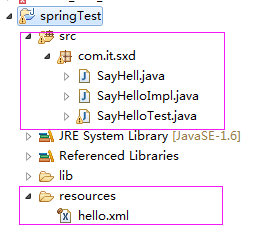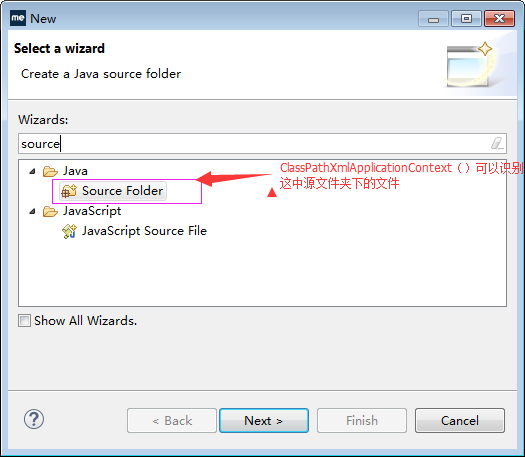【spring 区别】ClassXmlAplicationContext和FileSystemXmlApplicationContext的区别
今天写一个简单的spring使用例子,遇到这个问题:
项目结构如下:

代码如下:
package com.it.sxd; import java.nio.file.FileSystem; import org.junit.Test;
import org.springframework.context.ApplicationContext;
import org.springframework.context.support.ClassPathXmlApplicationContext;
import org.springframework.context.support.FileSystemXmlApplicationContext; public class SayHelloTest { @Test
public void testSayHello(){
//1.读取hello。xml配置文件,实例化一个Ioc容器
ApplicationContext context = new ClassPathXmlApplicationContext("hello.xml"); //2.从Ioc容器中获取ID为"hello1"的bean ,此处是“面向接口编程 而不是面向实现编程”
SayHell sayHell = context.getBean("hello1",SayHell.class);
//3.实现功能
sayHell.sayHello();
} }
代码中使用ClassPathXmlApplicationContext获取一个Ioc的实例化对象,但是读取这个"hello.xml"文件,无论怎么修改路径,修改成"resources/hello.xml"或者"hello.xml",总之是没有办法识别,一直报如下的错误:
org.springframework.beans.factory.BeanDefinitionStoreException: IOException parsing XML document from class path resource [resources/hello.xml]; nested exception is java.io.FileNotFoundException: class path resource [resources/hello.xml] cannot be opened because it does not exist
at org.springframework.beans.factory.xml.XmlBeanDefinitionReader.loadBeanDefinitions(XmlBeanDefinitionReader.java:344)
at org.springframework.beans.factory.xml.XmlBeanDefinitionReader.loadBeanDefinitions(XmlBeanDefinitionReader.java:304)
at org.springframework.beans.factory.support.AbstractBeanDefinitionReader.loadBeanDefinitions(AbstractBeanDefinitionReader.java:181)
at org.springframework.beans.factory.support.AbstractBeanDefinitionReader.loadBeanDefinitions(AbstractBeanDefinitionReader.java:217)
at org.springframework.beans.factory.support.AbstractBeanDefinitionReader.loadBeanDefinitions(AbstractBeanDefinitionReader.java:188)
at org.springframework.beans.factory.support.AbstractBeanDefinitionReader.loadBeanDefinitions(AbstractBeanDefinitionReader.java:252)
at org.springframework.context.support.AbstractXmlApplicationContext.loadBeanDefinitions(AbstractXmlApplicationContext.java:127)
at org.springframework.context.support.AbstractXmlApplicationContext.loadBeanDefinitions(AbstractXmlApplicationContext.java:93)
at org.springframework.context.support.AbstractRefreshableApplicationContext.refreshBeanFactory(AbstractRefreshableApplicationContext.java:129)
at org.springframework.context.support.AbstractApplicationContext.obtainFreshBeanFactory(AbstractApplicationContext.java:609)
at org.springframework.context.support.AbstractApplicationContext.refresh(AbstractApplicationContext.java:510)
at org.springframework.context.support.ClassPathXmlApplicationContext.<init>(ClassPathXmlApplicationContext.java:139)
at org.springframework.context.support.ClassPathXmlApplicationContext.<init>(ClassPathXmlApplicationContext.java:83)
at com.it.sxd.SayHelloTest.testSayHello(SayHelloTest.java:12)
at sun.reflect.NativeMethodAccessorImpl.invoke0(Native Method)
at sun.reflect.NativeMethodAccessorImpl.invoke(NativeMethodAccessorImpl.java:57)
at sun.reflect.DelegatingMethodAccessorImpl.invoke(DelegatingMethodAccessorImpl.java:43)
at java.lang.reflect.Method.invoke(Method.java:606)
at org.junit.runners.model.FrameworkMethod$1.runReflectiveCall(FrameworkMethod.java:50)
at org.junit.internal.runners.model.ReflectiveCallable.run(ReflectiveCallable.java:12)
at org.junit.runners.model.FrameworkMethod.invokeExplosively(FrameworkMethod.java:47)
at org.junit.internal.runners.statements.InvokeMethod.evaluate(InvokeMethod.java:17)
at org.junit.runners.ParentRunner.runLeaf(ParentRunner.java:325)
at org.junit.runners.BlockJUnit4ClassRunner.runChild(BlockJUnit4ClassRunner.java:78)
at org.junit.runners.BlockJUnit4ClassRunner.runChild(BlockJUnit4ClassRunner.java:57)
at org.junit.runners.ParentRunner$3.run(ParentRunner.java:290)
at org.junit.runners.ParentRunner$1.schedule(ParentRunner.java:71)
at org.junit.runners.ParentRunner.runChildren(ParentRunner.java:288)
at org.junit.runners.ParentRunner.access$000(ParentRunner.java:58)
at org.junit.runners.ParentRunner$2.evaluate(ParentRunner.java:268)
at org.junit.runners.ParentRunner.run(ParentRunner.java:363)
at org.eclipse.jdt.internal.junit4.runner.JUnit4TestReference.run(JUnit4TestReference.java:50)
at org.eclipse.jdt.internal.junit.runner.TestExecution.run(TestExecution.java:38)
at org.eclipse.jdt.internal.junit.runner.RemoteTestRunner.runTests(RemoteTestRunner.java:459)
at org.eclipse.jdt.internal.junit.runner.RemoteTestRunner.runTests(RemoteTestRunner.java:675)
at org.eclipse.jdt.internal.junit.runner.RemoteTestRunner.run(RemoteTestRunner.java:382)
at org.eclipse.jdt.internal.junit.runner.RemoteTestRunner.main(RemoteTestRunner.java:192)
Caused by: java.io.FileNotFoundException: class path resource [resources/hello.xml] cannot be opened because it does not exist
at org.springframework.core.io.ClassPathResource.getInputStream(ClassPathResource.java:172)
at org.springframework.beans.factory.xml.XmlBeanDefinitionReader.loadBeanDefinitions(XmlBeanDefinitionReader.java:330)
... 36 more
提示这个文件不存在,找不到。
好吧 ,我要爆炸了!!!
听说基友解读了一番,将ClassXmlAplicationContext()方法替换成FileSystemXmlApplicationContext()方法,代码如下:
package com.it.sxd; import java.nio.file.FileSystem; import org.junit.Test;
import org.springframework.context.ApplicationContext;
import org.springframework.context.support.ClassPathXmlApplicationContext;
import org.springframework.context.support.FileSystemXmlApplicationContext; public class SayHelloTest { @Test
public void testSayHello(){
//1.读取hello。xml配置文件,实例化一个Ioc容器
ApplicationContext context = new FileSystemXmlApplicationContext("resources/hello.xml"); //2.从Ioc容器中获取ID为"hello1"的bean ,此处是“面向接口编程 而不是面向实现编程”
SayHell sayHell = context.getBean("hello1",SayHell.class);
//3.实现功能
sayHell.sayHello();
} }
然后:

效果很好嘛~~!!!然后就好了。
下面就解读一下这两个方法的区别:
Spring容器最基本的接口就是BeanFactory. BeanFactory负责配置、创建、管理Bean,它有一个子接口ApplicationContext,也称为Spring上下文。Spring容器负责管理Bean与Bean之间的信赖关系。
BeanFactory有很多实现类,通常使用org.springframework.beans.factory.xml.XmlBeanFactory类。但对于大部分J2EE应用而言,推荐使用ApplicationContext. ApplicationContext是BeanFactory的子接口,其常用实现类是org.springframework.context.support.FileSystemXmlApplicationContext和org.springframework.context.support.ClassXmlAplicationContext。
Springr的配置信息通常采用XML配置文件来设置,因此,创建BeanFactory实例时,应该提供XML配置文件作为参数。、
下面详细介绍ApplicationContext的实际运用:
一:ClassPathXmlApplicationContext
1.没有前缀:默认为项目的classpath下相对路径
ApplicationContext appCt = new ClassPathXmlApplicationContext("app.spring.xml");
2.前缀classpath:表示的是项目的classpath下相对路径
ApplicationContext appCt = new ClassPathXmlApplicationContext("classpath:app.spring.xml");
3.使用前缀file 表示的是文件的绝对路径
ApplicationContext appCt = new ClassPathXmlApplicationContext("file:D:/app.spring.xml");
4.可以同时加载多个文件
String[] xmlCfg = new String[] { "classpath:base.spring.xml","app.spring.xml"};
ApplicationContext appCt = new ClassPathXmlApplicationContext(xmlCfg);
5.使用通配符加载所有符合要求的文件
ApplicationContext appCt = new ClassPathXmlApplicationContext("*.spring.xml");
也就是说呢,这个ClassPathXmlApplicationContext()方法,只能识别源文件夹的范围下的东西。

二:FileSystemXmlApplicationContext
1.默认为项目工作路径 即项目的根目录
ApplicationContext appCt2 = new FileSystemXmlApplicationContext("src/main/resources/app.spring.xml");
2.前缀classpath:表示的是项目的classpath下相对路径
ApplicationContext appCt2 = new FileSystemXmlApplicationContext("classpath:app.spring.xml");
3.使用前缀file 表示的是文件的绝对路径
ApplicationContext appCt2 = new FileSystemXmlApplicationContext("file:D:/app.spring.xml");
ApplicationContext appCt2 = new FileSystemXmlApplicationContext("D:/app.spring.xml");
4.可以同时加载多个文件
String[] xmlCfg = new String[] { "src/main/resources/base.spring.xml","classpath:app.spring.xml"};
ApplicationContext appCt2 = new FileSystemXmlApplicationContext(xmlCfg);
5.使用通配符加载所有符合要求的文件
ApplicationContext appCt2 = new FileSystemXmlApplicationContext("classpath:*.spring.xml");
代码解释:
import org.springframework.context.ApplicationContext;
import org.springframework.context.support.ClassPathXmlApplicationContext;
import org.springframework.context.support.FileSystemXmlApplicationContext;
import aoplog.LogAfterAdvice;
import aoplog.LogBeforeAdvice;
/**
* @author Michael
*
*/
public class TestApplicationContext {
/**
* @param args
*/
public static void main(String[] args) {
/**
* ClassPathXmlApplicationContext
*/
// 没有前缀:默认为项目的classpath下相对路径
ApplicationContext appCt = new ClassPathXmlApplicationContext(
"app.spring.xml");
// 前缀classpath:表示的是项目的classpath下相对路径
// ApplicationContext appCt = new ClassPathXmlApplicationContext(
// "classpath:app.spring.xml");
// 使用前缀file 表示的是文件的绝对路径
// ApplicationContext appCt = new ClassPathXmlApplicationContext(
// "file:D:/app.spring.xml");
LogBeforeAdvice logBefore = (LogBeforeAdvice) appCt
.getBean("logBefore");
System.out.println("ClassPathXmlApplicationContext test:"
+ logBefore.getClass());
// 利用通配符文件加载
ApplicationContext appCtXx = new ClassPathXmlApplicationContext(
"*.spring.xml");
// 多文件加载
String[] xmlCfg = new String[] { "classpath:base.spring.xml",
"myapp.spring.xml" };
ApplicationContext appCtMore = new ClassPathXmlApplicationContext(
xmlCfg);
/*
* FileSystemXmlApplicationContext
*/
// 默认为项目工作路径 即项目的根目录
ApplicationContext appCt2 = new FileSystemXmlApplicationContext(
"src/main/resources/app.spring.xml");
// 前缀classpath:表示的是项目的classpath下相对路径
// ApplicationContext appCt2 = new FileSystemXmlApplicationContext(
// "classpath:app.spring.xml");
// 使用前缀file 表示的是文件的绝对路径
// ApplicationContext appCt2 = new FileSystemXmlApplicationContext(
// "file:D:/app.spring.xml");
LogAfterAdvice logAfter = (LogAfterAdvice) appCt2.getBean("logAfter");
System.out.println("FileSystemXmlApplicationContext test:"
+ logAfter.getClass());
}
}
附录:
谈一谈什么是ClassPath以及怎么使用它:
首先:
java运行时的类路径,比如导入的类,在运行时需要将jar包放到classpath路径上。
classpath 在classpath路径上寻找指定文件,如果有多个符合的文件,以第一个为准,也就说,只要找到一个,就不在继续搜索
classpath*:会搜索所有满足条件的文件,有多少加载多少
其次:
编写的java源文件经过编译后生成class文件,需要指定目录存放这些文件。web程序默认都在web-info/classes目录下存放我们的java编译后的文件。
但是web-info目录下还有各种jar包和配置文件呢,确切说web-info根目录才是程序运行时classpath。放在根目录下的源代码,在编译之后,会将此文件copy到web-info目录。
JAVA获取classpath路径:
public URL getResource (String name);
public InputStream getResourceAsStream (String name);
这里name是资源的类路径,它是相对与“/”根路径下的位置。getResource得到的是一个URL对象来定位资源,而getResourceAsStream取得该资源输入流的引用保证程序可以从正确的位置抽取数据。
但是真正使用的不是ClassLoader的这两个方法,而是Class的 getResource和getResourceAsStream方法,因为Class对象可以从你的类得到(如YourClass.class或 YourClass.getClass()),而ClassLoader则需要再调用一次YourClass.getClassLoader()方法,不过根据JDK文档的说法,Class对象的这两个方法其实是“委托”(delegate)给装载它的ClassLoader来做的,所以只需要使用 Class对象的这两个方法就可以了。
因此,直接调用 this.getClass().getResourceAsStream(String name) ;获取流,静态化方法中则使用ClassLoader.getSystemResourceAsStream (String name) ; 。
下面是一些得到classpath和当前类的绝对路径的一些方法。你可能需要使用其中的一些方法来得到你需要的资源的绝对路径。
1.this.getClass().getResource("")
得到的是当前类class文件的URI目录。不包括自己!
如:file:/D:/workspace/jbpmtest3/bin/com/test/
2.this.getClass().getResource("/")
得到的是当前的classpath的绝对URI路径 。
如:file:/D:/workspace/jbpmtest3/bin/
3.this.getClass() .getClassLoader().getResource("")
得到的也是当前ClassPath的绝对URI路径 。
如:file:/D:/workspace/jbpmtest3/bin/
4.ClassLoader.getSystemResource("")
得到的也是当前ClassPath的绝对URI路径 。
如:file:/D:/workspace/jbpmtest3/bin/
5.Thread.currentThread().getContextClassLoader ().getResource("")
得到的也是当前ClassPath的绝对URI路径 。
如:file:/D:/workspace/jbpmtest3/bin/
6.ServletActionContext.getServletContext().getRealPath(“/”)
Web应用程序 中,得到Web应用程序的根目录的绝对路径。这样,我们只需要提供相对于Web应用程序根目录的路径,就可以构建出定位资源的绝对路径。
如:file:/D:/workspace/.metadata/.plugins/org.eclipse.wst.server.core/tmp0/wtpwebapps/WebProject
注意点:
1.尽量不要使用相对于System.getProperty("user.dir")当前用户目录的相对路径。这是一颗定时炸 弹,随时可能要你的命。
2.尽量使用URI形式的绝对路径资源。它可以很容易的转变为URI,URL,File对象。
3.尽量使用相对classpath的相对路径。不要使用绝对路径。使用上面ClassLoaderUtil类的public static URL getExtendResource(String relativePath)方法已经能够使用相对于classpath的相对路径定位所有位置的资源。
4.绝对不要使用硬编码的绝对路径。因为,我们完全可以使用ClassLoader类的getResource("")方法得到当前classpath的绝对路径。如果你一定要指定一个绝对路径,那么使用配置文件,也比硬编码要好得多!
【spring 区别】ClassXmlAplicationContext和FileSystemXmlApplicationContext的区别的更多相关文章
- Spring中ClassPathXmlApplication与FileSystemXmlApplicationContext的区别
Spring中ClassPathXmlApplication与FileSystemXmlApplicationContext的区别 一.概述 在项目中遇到加载不到Spring配置文件,简单分析后,写此 ...
- Spring中ClassPathXmlApplication与FileSystemXmlApplicationContext的区别以及ClassPathXmlApplicationContext 的具体路径
一.ClassPathXmlApplicationContext 的具体路径 String s[] = System.getProperty("java.class.path"). ...
- Spring 注释 @Autowired 和@Resource 的区别
Spring 注释 @Autowired 和@Resource 的区别 一. @Autowired和@Resource都可以用来装配bean,都可以写在字段上,或者方法上. 二. @Autowired ...
- Spring和SpringBoot比较,解惑区别
1.概述: 对于Spring和SpringBoot到底有什么区别,我听到了很多答案,刚开始迈入学习SpringBoot的我当时也是一头雾水,随着经验的积累.我慢慢理解了这两个框架到底有什么区别,我相信 ...
- Spring中BeanFactory与FactoryBean的区别
在Spring中有BeanFactory和FactoryBean这2个接口,从名字来看很相似,比较容易搞混. 一.BeanFactory BeanFactory是一个接口,它是Spring中工厂的顶层 ...
- Spring Boot @EnableAutoConfiguration和 @Configuration的区别
Spring Boot @EnableAutoConfiguration和 @Configuration的区别 在Spring Boot中,我们会使用@SpringBootApplication来开启 ...
- 【Java面试】Spring中 BeanFactory和FactoryBean的区别
一个工作了六年多的粉丝,胸有成竹的去京东面试. 然后被Spring里面的一个问题卡住,唉,我和他说,6年啦,Spring都没搞明白? 那怎么去让面试官给你通过呢? 这个问题是: Spring中Bean ...
- jQuery方法区别:click() bind() live() delegate()区别
今天看到一篇jquery 事件的文章,自己写了个小例子,虽然2种方式都可以实现,但是不太明白,找了点资料 $("#box1").delegate("p",&qu ...
- JAVA基础之——三大特征、接口和抽象类区别、重载和重写区别、==和equals区别、JAVA自动装箱和拆箱
1 java三大特征 1)封装:即class,把一类实体定义成类,该类有变量和方法. 2)继承:从已有的父类中派生出子类,子类实现父类的抽象方法. 3)多态:通过父类对象可以引用不同的子类,从而实现不 ...
随机推荐
- 编译安装apache下添加mod_rewrite支持
今天我依旧在学习我的编程语言,接到同事的一个请求.说在25*服务器上添加一个apache的mod_rewrite的模块支持 感觉还好了,这个很简单,所有就开始做了.不过这个服务器已经相当久远了,一下吧 ...
- html 的table tr td的使用
cellspacing 属性规定单元格之间的空间. cellpadding 属性规定单元边沿与其内容之间的空白. border 简写属性在一个声明设置所有的边框属性. border 用在table属性 ...
- (转载)解决ListView中使用EditText所遇到的一些冲突
大家都知道在listView中使用editText,在输入过程中是有冲突的.今天稍微研究了一下这个问题,有一点点小小的心得和大家一起分享下. 首先建立一个最简单的demo,主界面就是一个ListVie ...
- SGU 179 Brackets light(生成字典序的下一个序列)
题目链接:http://acm.sgu.ru/problem.php?contest=0&problem=179 解题报告:输入一个合法的括号串,求出这个括号串的字典序的下一个串.(认为'(' ...
- 采用Unity快速开发高质量游戏的若干优化建议
http://files.cnblogs.com/123ing/%E9%87%87%E7%94%A8Unity%E5%BF%AB%E9%80%9F%E5%BC%80%E5%8F%91%E9%AB%98 ...
- [codeforces 260]B. Ancient Prophesy
[codeforces 260]B. Ancient Prophesy 试题描述 A recently found Ancient Prophesy is believed to contain th ...
- HTML 笔记,持续更新
一.文本格式化标签 <b> 定义粗体文本. <big> 定义大号字. <em> 定义着重文字. <i> 定义斜体字. <small> 定义小 ...
- HXOI 2014 PSet 4 Day 1 一模04日1 题解
1. 最小花费(money.pas/c/cpp) 问题描述 在n个人中,某些人的银行账号之间可以互相转账.这些人之间转账的手续费各不相同.给定这些人之间转账时需要从转账金额里扣除百分之几的手续费,请问 ...
- Android 下载文件及写入SD卡
Android 下载文件及写入SD卡,实例代码 <?xml version="1.0" encoding="utf-8"?> <LinearL ...
- 【云计算】Docker云平台—Docker进阶
Docker云平台系列共三讲,此为第二讲:Docker进阶 参考资料: 五个Docker监控工具的对比:http://www.open-open.com/lib/view/open1433897177 ...
